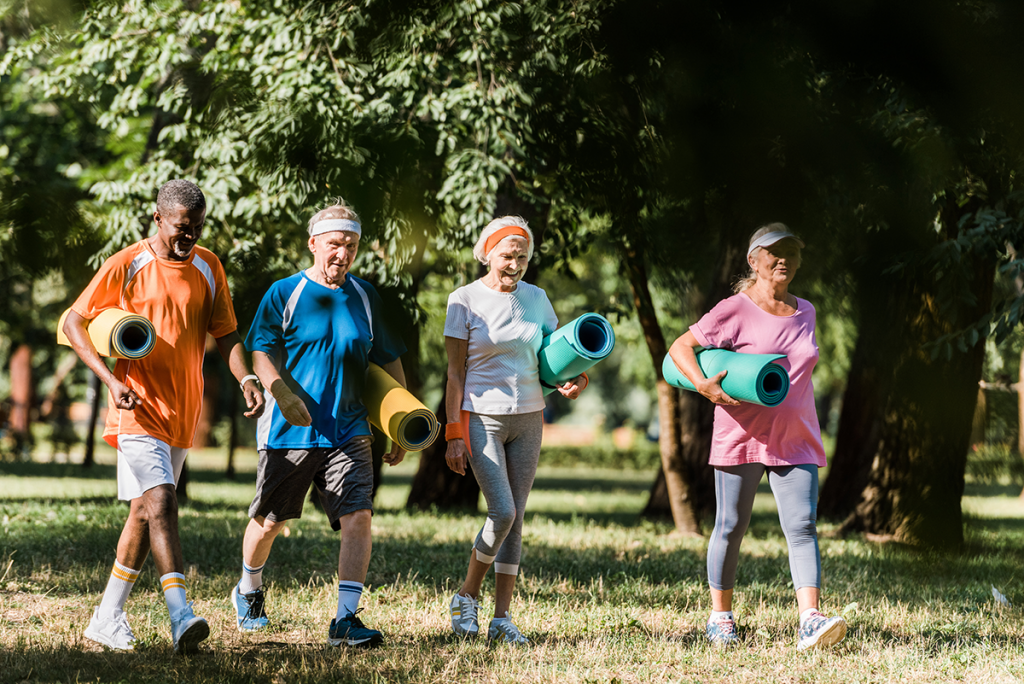
We all love our mobility because it offers us the freedom to move more freely and live more fully. When we are young we can run, jump, climb, skip and move our body in all directions, freely and easily. As we grow older and more sedentary, our mobility begins to decline gradually.
We barely notice the small incremental losses until we are challenged to perform out-of-the-ordinary tasks like walking uphill, dancing at a wedding or climbing several flights of stairs. That’s when we feel fatigue, stiffness and weakness. Difficulty performing an activity that was once easy is a marker of diminution and a wake-up call to be proactive to regain vitality.
We have control over how we age, and we can prevent functional decline regardless of what we are repeatedly told. I find it disturbing that many friends and colleagues in the healthcare world chalk up difficulty walking, climbing stairs or performing activities of daily living to “just part of aging.”
Mobility disability might be common, but it doesn’t mean it’s inevitable. Forty percent of Americans 65 years of age and up have difficulty walking ¼ mile and climbing stairs.(1) People in the Blue Zones live healthier and longer, largely because of positive lifestyle choices including daily physical activity and a healthy plant-based diet. Let’s pull the curtain back on where mobility comes from, so we can see that our lifestyle choices play a starring role in how well we age or how rapidly we decline.
Mobility Systems
Every day we find ourselves walking, bending, squatting, lifting, carrying, twisting, turning and reaching as we perform our daily routines. While these tasks all sound simple, they are incredibly complex because a network of systems need to work in a specific way to coordinate movement. On demand and simultaneously, the central nervous system (brain and spinal cord), peripheral nervous system, muscles, bones and joints, sensory and energetic systems all need to function together to accomplish each activity successfully.
Mobility Decline
Losing mobility as we age is accelerated by inactivity and is usually the result of multiple impairments in one or more of the body’s systems including: bone and joints, muscle, the central nervous system and energetic systems.(2) All systems depend on energy production. Just like talking on a cell phone requires a charged battery and driving a car needs gasoline in the tank.
We need energy to fuel our body’s entire metabolism to function properly. Research over the last decade is pointing to mitochondrial dysfunction as a huge factor contributing to the age-related loss of muscle mass, strength and function (sarcopenia) and mobility loss.(3)
Mighty Mitochondria
Recall from Biology 101 that mitochondria are the “powerhouses” of the cell; converting carbohydrates, fats, and proteins from the food we eat into energy. (They also carry out a wide range of critical actions, but that topic is beyond this article’s scope.)
There are approximately 1,000- 2,500 mitochondria in each cell!(4) The higher the energy demand, the more mitochondria the cell will contain. Our brain, heart, muscles and nerves are densely populated with mitochondria, making up about 25% of each cell’s volume.(4) When the cell can’t keep up with energy demands, the mitochondria can become damaged; we’re left feeling tired, forgetful and weak.
Supporting Mitochondria
Altered mitochondrial function is associated with free radical production, inflammation, accelerated aging, chronic disease(5) and sarcopenia.(3) As we grow older, our ability to produce energy decreases but we can make it more efficient by adjusting our lifestyle, environment and diet.(5) Here’s how:
- Eat plants and proteins: Fill your plate with about 30 grams of protein and a rainbow of fresh vegetables at each meal and enjoy 1-2 fruits daily.
- Move more daily: Move joints through their full range of motion to boost circulation and reduce stiffness and inflammation.
- Cross-train alternating aerobic and resistance training: Helps strengthen mitochondrial function, build muscle and improve energy production.
- Breathe deeply into your belly: This decreases stress and inflammation.
- Explore supplementation: A high-quality multivitamin/multimineral and antioxidants like N-acetylcysteine, alpha-lipoic acid, CoQ10, plus acetyl-l-carnitine, resveratrol, and vitamin E have been shown to help jump start mitochondrial function.(4) (Educate yourself and consult with a qualified healthcare practitioner)
- Avoid or eliminate environmental toxins: Pesticides, Teflon, BPA and phthalates to name a few.
- Review medications with your doctor: Prescription and over-the-counter drugs like acetaminophen, antibiotics and statins can damage mitochondria.(4)
It’s a lengthy list but start by exploring one at a time. Exercising to the point where you feel energized is highly recommended. Avoid exercise that leaves you feeling exhausted; it’s simply too much and causes mitochondrial damage. Be “proactive” and build a new habit to benefit your mitochondria so you can move more freely and live more fully!
Fit Pros: Guide Older Clients as a Geriatric Fitness and Lifestyle Specialist
Millions of people over age 65 looking for guidance from fitness professionals who are knowledgeable in exercise, nutrition and lifestyle principles that can help them improve functional mobility, while also preventing and managing chronic conditions to live their highest quality of life. The Geriatric Fitness and Lifestyle Specialist online certificate course will give you insights, strategies and tools to be a successful professional in this rapidly growing market. Learn how to be a valued part of clients’ continuum of care, working with the medical team to improve functional outcomes and positively impact people’s lives.

Cate Reade, MS, RD is a Registered Dietitian and Exercise Physiologist on a mission to improve functional mobility and health span utilizing the power of lifestyle medicine. She has been teaching, writing and prescribing healthy eating and exercise programs for over 25 years. Today, as CEO of Resistance Dynamics and inventor of the MoveMor™ Mobility Trainer, she develops exercise products and programs that target joint flexibility, strength and balance deficits to help older adults fall less and live more.
References
- Centers for Disease Control and Prevention: https://www.cdc.gov/media/releases/2018/p0816-disability.html
- Stenholm, S., et al. (2015). Physiological factors contributing to mobility loss over 9 years of follow-up—results from the InCHIANTI study. The journals of gerontology. Series A, Biological sciences and medical sciences, 70(5), 591–597. doi:10.1093/gerona/glv004
- Coen, P. M., et al. (2019). Mitochondria as a Target for Mitigating Sarcopenia. Frontiers in physiology, 9, 1883. doi:10.3389/fphys.2018.01883
- Pizzorno J. (2014). Mitochondria-Fundamental to Life and Health. Integrative medicine (Encinitas, Calif.), 13(2), 8–15.
- Bland, J.S. (2014) The Disease Delusion. New York, NY: HarperCollins.

